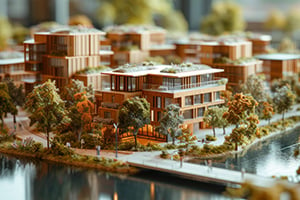This first edition in an on-going series, LEED 101, breaks down the LEED certification process bite by bite. The very first step-even before registering your project-is confirming that your building can meet all seven Minimum Program Requirements. The requirements are the same for every rating system.
1. Must comply with environmental laws. Basically, don’t pollute. This is very easy for most buildings; a grey area for program types like coal fired power plants-the archenemy of LEED.
2. Must be a complete, permanent building or space. So many of the credits, from public transportation availability to solar energy generation, are very site specific. Moreover, LEED certification is an investment in a community, to it’s awareness and education of sustainable living. So all certifications are exclusively relevant to the GPS coordinate that they were originally certified at.
3. Must use a reasonable site boundary. ‘Reasonable’ is a nice word for ability to influence or control. The GBCI wants to ensure that if they give your building a LEED plaque, the associated grounds and site work will be maintained with the same use (ie: open space stays open) for the entire lifetime of the building. Bottomline, only claim what you own; don’t try to be sneaky and claim the nearby park or empty lot as your restored habitat.
4. Must comply with minimum floor area requirements. Yes, there is a minimum size for LEED buildings: 1,000 sf for whole buildings and 250 sf for interior spaces. There is no maximum.
5. Must comply with minimum occupancy rates. Yes, there is also a minimum number of occupants: 1 FTE (full time equivalent). Based on an 8-hour day, the building must be occupied by either one full-time staff, or a combination of part-time staff to equal eight hours.
6. Must commit to sharing whole-building energy and water use data. This is the most unusual and misunderstood MPR. I think it is also the most important for the future adoption and credibility of the LEED mark. The USGBC’s intention here is to collect data on actual building performance for five years after initial occupancy or certification, and use this data to show that LEED buildings out perform their ‘traditional’ counterparts. You have three options: use the EPA’s ENERGY STAR Portfolio Manager tool to share data online, commit to apply/re-certify for LEED EBO+M, or maintain your own records and submit upon request to the USGBC on a quarterly basis. My recommendation is to enroll-for free-in the ENERGY STAR program. This program will be explained in a future post on EBO+M prerequisites, but the short reason why it’s a good idea for your NC project is because the program is the industry standard for energy benchmarking.
7. Must comply with minimum building area to site area ratio. Similar to the site boundary requirement, the big idea here is a ‘reasonable’ definition of LEED Project Boundary. Gross floor area can be no less than 2% of gross land area.
**Acronyms defined:
LEED – Leadership in Energy and Environmental Design.
GBCI – Green Building Certification Institute. Non-profit entity that reviews LEED applications for certification, and issues plaques.
USGBC – United States Green Building Council. Non-profit entity that writes the LEED rating systems, and publishes the reference guides.
EPA – Environmental Protection Agency, a division of the federal government.
EBO+M – Existing Buildings Operation and Maintenance, one of nine LEED rating systems. (note: also synonymous with GBO+M-Green Building Operation and Maintenance.)
NC – New Construction, one of the three rating systems explained within the BD+C (Building Design and Construction) reference guide. The other two are Core and Shell (CS) and Schools (SCH).
© 2011 Sustainable Investment Group (SIG). All rights reserved.



